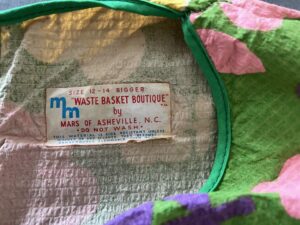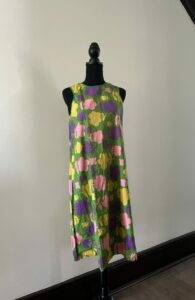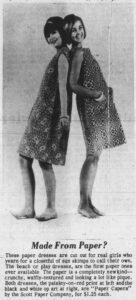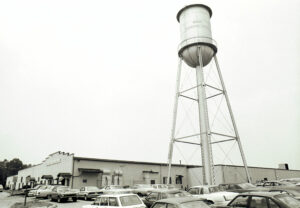
Waste Basket Boutique paper dresses were made in Asheville by Mars
Women could get a paper dress, branded a “Paper Caper,” by clipping a coupon from an advertisement in Seventeen magazine and sending it along with two proofs of purchase and $1.25 to Scott Paper Company’s offices in Philadelphia.



“I tried one out and wore it three days, cleaned the house, mopped, waxed the floors, washed five girls’ heads, bathed the dogs and did everything else necessary in a house with five bedrooms, two baths, ten people and two dogs and it was still in one piece,” wrote a young California mother of eight to the Mars Manufacturing Company of Asheville complementing their new disposable product – the paper dress.
“When we get ready to paint, I will get another and save ruining a cotton house dress,” the woman continued. “Also, at canning season, I intend to have three or four, as I always ruin a couple of dresses with stain from something,”
Originally conceived in 1966 as a marketing gimmick by the Scott Paper Company to sell more disposable paper products, the paper dress quickly became a fashion fad. Women could get a paper dress, branded a “Paper Caper,” by clipping a coupon from an advertisement in Seventeen magazine and sending it along with two proofs of purchase and $1.25 to Scott Paper Company’s offices in Philadelphia. (By contrast, a cotton dress from Sears cost between $5 and $10 at the time.)
The sleeveless, A-shaped dresses sold much better than Scott Paper expected. By the end of 1966, the company had received nearly 500,000 orders for the two patterns it offered – a red paisley print and a black and white Op-Art design.
Many Americans in the mid-1960s imagined a future defined by automation and convenience. Disposable clothing, then, would be a first step toward easing the burden on women’s daily lives by offering chic, inexpensive dresses in an increasing variety of patterns and designs – which never needed to be (and, in fact, couldn’t be) laundered.
Made from three plies of “crunchy, waffly-textured” paper reinforced with rayon – a new fabric termed “Duraweave,” the paper dress was also treated to be fire resistant, though the company warned, “It is flame resistant, but washing, dry cleaning, or soaking will make the dress dangerously flammable when dry.”
They could be easily altered. Want a shorter hemline? Just grab a pair of scissors. Tear a hole in the fabric? Fix it with some clear tape. Despite the notion that the dress was only meant to be worn once and thrown away, an article from early 1966 boasted of the dresses’ continued utility long after the first wearing. “A girl might wear a Caper to her next patio party, then for a few outings at the beach, and then get to work with her scissors! She can cut it down to a tunic, then a shell, then to unusual placemats.”
It didn’t take long for other companies to capitalize on Scott Paper’s marketing campaign – and one of the most successful was based in Asheville.
Mars Manufacturing Co., located on Johnston Boulevard in West Asheville, had already developed its own line of paper dresses the year before, though it hadn’t sold many. But with Scott Paper’s success, demand for the dresses skyrocketed and by mid-1966, Mars launched Waste Basket Boutique.
Asheville resident Bob Bayer, the son-in-law of Mars’ founders, began working at the company in 1960, several years before paper dresses became popular. Bayer, a mechanical engineer in his 20s, helped Mars – in collaboration with Kimberly Clark Corporation and J.P. Stevens – develop a prototype for disposable paper underwear for the military. Unfortunately, the paper prototype didn’t hold up to the constant walking required of the troops deployed to Vietnam and would begin to flake, leaving a literal paper trail in their wake.
So Bayer and another executive at Mars, Ron Bard, shifted to developing paper-based fashion. The paper fabric Mars used was known as Kaycel, made of 93% cellulose and 7% nylon.
Unable to afford to hire a dress designer, Bayer brought in his wife, Audie Bayer, to put together the line. “I would make a picture of a dress and cut out a piece of gift wrap and stick it on it. And I’d say to Bob, ‘There. Make that,’” Audie said in a 2007 interview. “It was the perfect time,” she continued. “You didn’t have anybody professional who knew what they were doing. Bob didn’t know enough to argue with me.”
Audie’s design sensibilities pushed the brand to be the top paper dress producer in the United States. At peak demand, Mars shipped out more than 80,000 paper garments for Waste Basket Boutique each week including floor-length gowns, jumpsuits, coats, jerseys, ponchos, and even men’s swim trunks. It processed not only individual orders, but large orders from department stores like Macy’s, Sears, Lord & Taylor, and J.C. Penney.
More than a utilitarian garment, paper dresses became popular at parties. In December 1966, The Charlotte News reported on a “posh paper ball in Hartford, Connecticut, where all the female guests wore paper. Some ball gowns were from Mars, others were thousand-dollar creations of famous couturiers.”
Mars also marketed a paint-your-own dress, which for $6 came with a set of watercolors. According to The Charlotte News, “Hostesses mail the dress and watercolors to guests with the invitations. Each female guest decorates her dress and prizes go to the most imaginative.” The article continued, “A hostess in Asheville asked each woman to put on one of the plain white dresses, then the husbands painted designs on them.”
An advertisement for paper dresses in the March 25, 1966, Santa Maria Times.
During this boom period, Mars Manufacturing foresaw “a day (not far off) when most of us will wear disposable clothing at least part of the time. It may be packaged in tear-off rolls, like paper bags.”
But, by 1969, the market had changed. As the environmental movement gained momentum, the popularity of disposable fast fashion declined and hundreds of thousands of paper dresses moved from closet to waste basket to landfill without new orders being placed.
Mars Manufacturing cut its losses and shifted production to disposable industrial and surgical clothing. Bob Bayer recalled in 2007: “This paper dress thing helped us get into these other fields. It had to run out at some point.”
Anne Chesky Smith is the executive director of Asheville Museum of History.
